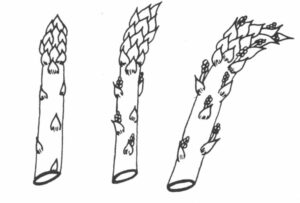
Produce Spotlight: Asparagus
April is peak asparagus season! It’s also one of the first spring vegetables to be ready for harvest. Asparagus is crisp and tender when cooked and is easy to grill at family cookouts thanks to its long and sturdy shape.
The best way to get the freshest pick of the season is to head to your local farmers market. Find the closest SNAP-accepting market here. Asparagus harvest lasts from April to early June in northern Oklahoma. In southern Oklahoma, harvest begins about a week earlier, so they may be available to you sooner or later depending on where you live.
How to Choose
For fresh asparagus, choose bunches with stalks that are bright green or purple-tinged with firm stems. Avoid limp or wilted stalks. Thicker stalks have a stronger asparagus flavor while thin stems are more tender and sweet.
When looking at the spearhead, look for heads that are tight, like on the left side of the photo below, and not “ferned out”.

Photo courtesy of OSU Extension Program
If you enjoy pickled asparagus over fresh, look for varieties that have little to no added salt to reduce sodium intake.
How to Store:
Trim ends and wrap in a damp paper towel or place ends in a cup filled with 1 inch water. Cover tops with a plastic bag and refrigerate for up to 3 days.
Tip: Trim just the pale ends of the stalks, where the color turns from white to green, to remove the tough, woody part!
How to Cook:
While you can eat asparagus raw, most prefer to have it cooked due to its tougher texture. Luckily, asparagus is a versatile vegetable that’s quick to cook and easy to add to so many dishes! Not sure where to start? We’ve got plenty of ideas for you!
- Try something with a kick with Spicy Shrimp Linguine with Asparagus.
- Add chopped asparagus to our Summer Squash Saute, simply toss it in with the rest of the vegetables!
- Substitute asparagus for zucchini in our Healthy Garden Veggie Frittata
- Use asparagus instead of cauliflower in our Roasted Fennel Pork Chops to make it seasonal!
Asparagus also shines on its own as a side dish with your favorite seasonings. Try it with garlic, parmesan and a squeeze of fresh lemon!
Asparagus Nutrition
Asparagus is a great source of fiber, vitamin K, and folate! Fiber is beneficial to gut health and may help lower blood cholesterol. Vitamin K assists in blood clotting, which helps us heal from cuts and wounds. Folate helps in making new cells in our bodies, which is why it’s so important during pregnancy.
Summary
Asparagus is in season from April to June and is easy to find at your local farmer’s market! It is nutrient packed and easy to prepare with a handful of ONIE recipes. What is your favorite way to prepare asparagus? Let us know in the comments below!



Hello!
I found your write up on asparagus from USDA SNAP-ed webpage on asparagus. I am doing a little bit of research, as I am a retail dietitian that will be filming a TikTok around the importance of cooking raw asparagus before consuming. The head of our Food Safety team brought it to our attention that since asparagus is treated as a “rarely consumed raw” vegetable by the USDA, that farms do not need to follow the same food safety guidelines during farming/production/handling as other vegetables, we should not be instructing consumers to eat raw asparagus. Have you happen to run into this with your education?